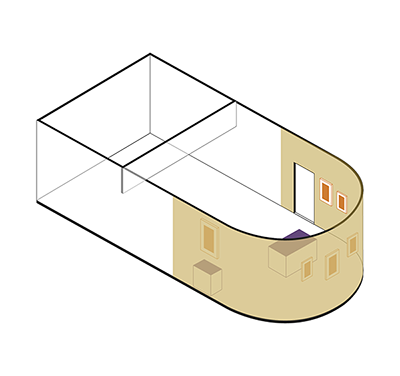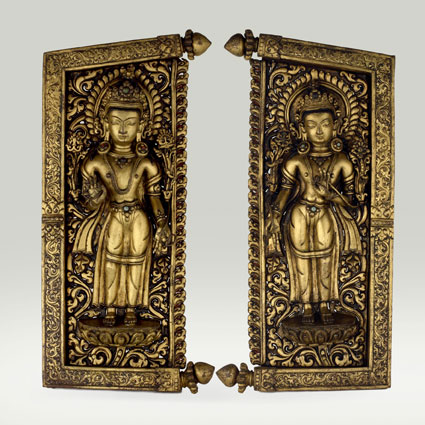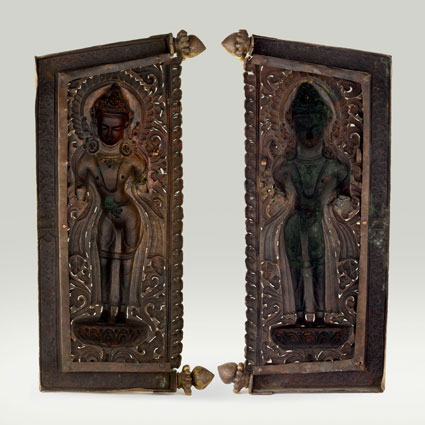
ABS 018
Code: ABS 018
Country: Tibet (central)
Style: Nepalese School
Date: 1500 - 1600
Dimensions in cm WxHxD: 18.1 x 48.5 x 2.3
Materials: Hammered copper
The crowns and the other jewelled ornaments are inset with turquoise, coral and glass underlaid with red foil.
These images form a pair of male Bodhisattva deities composed of Vajrapani (Tib. Phyag na rdo rje) (left) and Manjusri (Tib. ’Jam dpal dbyangs) (right). The Bodhisattvas are standing in a slightly bent attitude (abhanga) on a single lotus pedestal. The right hand of Vajrapani is extended in the gesture of charity (varada-mudra) and the left hand lifted in the gesture of argumentation (vitarka-mudra). Manjusri has the right hand lifted in the gesture of argumentation (vitarka-mudra) and extends the left hand in the gesture of charity (varada-mudra). Both figures hold in the hands the stalk of a lotus flowering at shoulder levels and decorated with the appropriate attributes, namely the diamond sceptre (vajra) of Vajrapani, respectively the sword (khadga) of Manjusri.
The Bodhisattvas are clad with a cloth tied around the waists with a belt. They wear princely ornaments, namely five-pointed crowns, a pairs of earrings, two necklaces, bracelets at upper arms and wrists, and pairs of anklets. The Bodhisattvas are set against a background composed of scrolling patterns and the heads against a nimbus decorated with rays. Three sides of the brackets are composed of rectangular shaped bars with scrolling pattern and the remaining side with a flaming border.
Manjusri and Vajrapani, together with Avalokitesvara Padmapani, are the most popular ones among the Bodhisattvas.
This pair of embossed images originate from Southern Tibet and reflect a distinct Newar influence in the technique applied.
Vajrapani (from Sanskrit vajra, "thunderbolt" or "diamond" and pani, lit. "in the hand") is one of the earliest bodhisattvas of Mahayana Buddhism. He is the protector and guide of the Buddha and rose to symbolize the Buddha's power. Vajrapani was used extensively in Buddhist iconography as one of the three protective deities surrounding the Buddha. Each of them symbolizes one of the Buddha's virtues: Manjusri (the manifestation of all the Buddhas' wisdom), Avalokitesvara (the manifestation of all the Buddhas' compassion) and Vajrapani (the manifestation of all the Buddhas' power)
Names
In Sanskrit, Vajrapani is known as Vajrapanina bodhisattvena mahasattvena, vajra-sattvaand, in Tibetan, as Lag na Rdo rje (Chana Dorji).
On the popular level, Vajrapani, Holder of the Thunderbolt Scepter (symbolizing the power of compassion), is the Bodhisattva who represents the power of all the Buddhas, just as Avalokitesvara represents their great compassion, Manjusri their wisdom, and Tara their miraculous deeds. For the yogi, Vajrapani is a means of accomplishing fierce determination and symbolizes unrelenting effectiveness in the conquest of negativity. His taut posture is the active warrior pose (pratayalidha), based on an archer's stance but resembling the en gardeposition in Western fencing. His outstretched right hand brandishes a vajra and his left hand deftly holds a lasso – with which he binds demons. He wears a skull crown with his hair standing on end. His expression is wrathful, and he has a third eye. Around his neck is a serpent necklace and his loin cloth is made up of the skin of a tiger, whose head can be seen on his right knee.
Iconography
The first representations of Vajrapani in India associated him with the Hindu God Indra. As Buddhism expanded in Central Asia, and fused with Hellenistic influences into Greco-Buddhism, the Greek hero Hercules was adopted to represent Vajrapani. He was then typically depicted as a hairy, muscular athlete, wielding a short "diamond" club. Mahayana Buddhism then further spread to China, Korea and Japan from the 6th century.
In Japan, Vajrapani is known as Shukongōshin ("Diamond rod-wielding God"), and has been the inspiration for the Nio (lit. Benevolent kings), the wrath-filled and muscular guardian god of the Buddha, standing today at the entrance of many Buddhist temples under the appearance of frightening wrestler-like statues.
"The origin of the image of Vajrapani should be explained. This deity is the protector and guide of the Buddha Shakyamuni. His image was modelled after that of Hercules. (...) The Gandharan Vajrapani was transformed in Central Asia and China and afterwards transmitted to Japan, where it exerted stylistic influences on the wrestler-like statues of the Guardian Deities (Nio)." (Katsumi Tanabe, "Alexander the Great, East-West cultural contacts from Greece to Japan", p23).
de Mallmann, Marie-Thérèse, 1975. Introduction à l'iconographie du tântrisme bouddhique. Paris: Adrien Mainsonneuve (Jean Maisonneuve successeur (1970). Pp. 250-257 - References to the iconography of Manjushri
de Mallmann, Marie-Thérèse, 1964. Étude iconographique sur Manjusri. Paris: École Française d’Extrème-Orient. References to the iconography of Manjushri
Sèngué, Tcheuky, 2002. Petite Encyclopédie des Divinités et symboles du Bouddhisme Tibétain. Editions Claire Lumiere . Pp. 164 / 185-191 - Références françaises sur Manjushri
Sèngué, Tcheuky, 2002. Petite Encyclopédie des Divinités et symboles du Bouddhisme Tibétain. Editions Claire Lumiere . Pp. 163/192-196 - Références françaises sur Vajrapani


